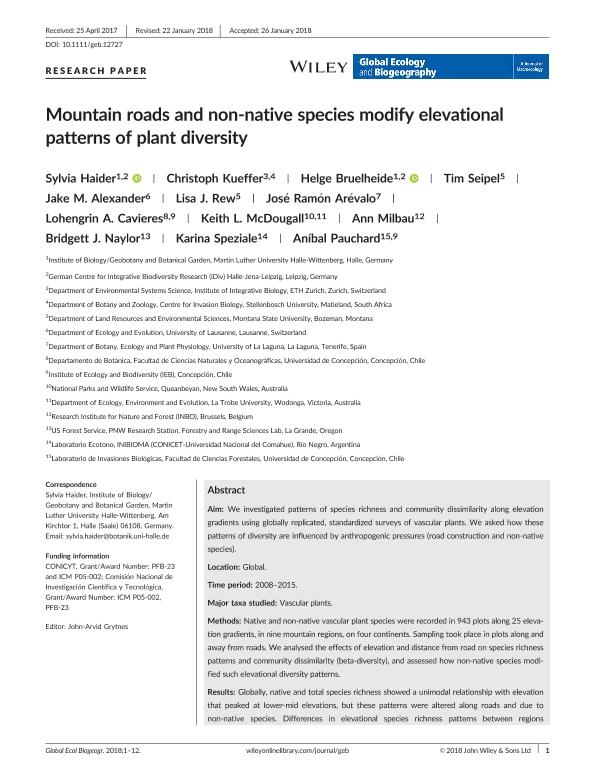Mostrar el registro sencillo del ítem
dc.contributor.author
Haider, Sylvia
dc.contributor.author
Kueffer, Christoph
dc.contributor.author
Bruelheide, Helge
dc.contributor.author
Seipel, Tim
dc.contributor.author
Alexander, Jake M.
dc.contributor.author
Rew, Lisa J.
dc.contributor.author
Arévalo, José Ramón
dc.contributor.author
Cavieres, Lohengrin A.
dc.contributor.author
McDougall, Keith L.
dc.contributor.author
Milbau, Ann
dc.contributor.author
Naylor, Bridgett J.
dc.contributor.author
Speziale, Karina Lilian

dc.contributor.author
Pauchard, Aníbal
dc.date.available
2019-11-26T21:11:01Z
dc.date.issued
2018-06
dc.identifier.citation
Haider, Sylvia; Kueffer, Christoph; Bruelheide, Helge; Seipel, Tim; Alexander, Jake M.; et al.; Mountain roads and non-native species modify elevational patterns of plant diversity; Wiley Blackwell Publishing, Inc; Global Ecology and Biogeography; 27; 6; 6-2018; 667-678
dc.identifier.issn
1466-822X
dc.identifier.uri
http://hdl.handle.net/11336/90585
dc.description.abstract
Aim: We investigated patterns of species richness and community dissimilarity along elevation gradients using globally replicated, standardized surveys of vascular plants. We asked how these patterns of diversity are influenced by anthropogenic pressures (road construction and non-native species). Location: Global. Time period: 2008–2015. Major taxa studied: Vascular plants. Methods: Native and non-native vascular plant species were recorded in 943 plots along 25 elevation gradients, in nine mountain regions, on four continents. Sampling took place in plots along and away from roads. We analysed the effects of elevation and distance from road on species richness patterns and community dissimilarity (beta-diversity), and assessed how non-native species modified such elevational diversity patterns. Results: Globally, native and total species richness showed a unimodal relationship with elevation that peaked at lower-mid elevations, but these patterns were altered along roads and due to non-native species. Differences in elevational species richness patterns between regions disappeared along roadsides, and non-native species changed the patterns’ character in all study regions. Community dissimilarity was reduced along roadsides and through non-native species. We also found a significant elevational decay of beta-diversity, which however was not affected by roads or non-native species. Main conclusions: Idiosyncratic native species richness patterns in plots away from roads implicate region-specific mechanisms underlying these patterns. However, along roadsides a clearer elevational signal emerged and species richness mostly peaked at mid-elevations. We conclude that both roads and non-native species lead to a homogenization of species richness patterns and plant communities in mountains.
dc.format
application/pdf
dc.language.iso
eng
dc.publisher
Wiley Blackwell Publishing, Inc

dc.rights
info:eu-repo/semantics/openAccess
dc.rights.uri
https://creativecommons.org/licenses/by-nc-sa/2.5/ar/
dc.subject
ALIEN
dc.subject
ALTITUDE
dc.subject
BETA-DIVERSITY
dc.subject
ELEVATIONAL DECAY
dc.subject
EXOTIC
dc.subject
HOMOGENIZATION
dc.subject
HUMP-SHAPED PATTERN
dc.subject
ROADSIDES
dc.subject
SPECIES REPLACEMENT
dc.subject
SPECIES TURNOVER
dc.subject.classification
Ecología

dc.subject.classification
Ciencias Biológicas

dc.subject.classification
CIENCIAS NATURALES Y EXACTAS

dc.title
Mountain roads and non-native species modify elevational patterns of plant diversity
dc.type
info:eu-repo/semantics/article
dc.type
info:ar-repo/semantics/artículo
dc.type
info:eu-repo/semantics/publishedVersion
dc.date.updated
2019-10-10T13:54:40Z
dc.journal.volume
27
dc.journal.number
6
dc.journal.pagination
667-678
dc.journal.pais
Reino Unido

dc.journal.ciudad
Londres
dc.description.fil
Fil: Haider, Sylvia. Martin Luther University; Alemania. German Centre for Integrative Biodiversity Research; Alemania
dc.description.fil
Fil: Kueffer, Christoph. Institute of Integrative Biology; Suiza. Stellenbosch University; Sudáfrica
dc.description.fil
Fil: Bruelheide, Helge. Martin Luther University; Alemania. German Centre for Integrative Biodiversity Research; Alemania
dc.description.fil
Fil: Seipel, Tim. State University of Montana; Estados Unidos
dc.description.fil
Fil: Alexander, Jake M.. Universite de Lausanne; Suiza
dc.description.fil
Fil: Rew, Lisa J.. Universite de Lausanne; Suiza
dc.description.fil
Fil: Arévalo, José Ramón. Universidad de La Laguna; España
dc.description.fil
Fil: Cavieres, Lohengrin A.. Universidad de Concepción; Chile
dc.description.fil
Fil: McDougall, Keith L.. National Parks and Wildlife Service; Australia. La Trobe University; Australia
dc.description.fil
Fil: Milbau, Ann. Research Institute for Nature and Forest; Bélgica
dc.description.fil
Fil: Naylor, Bridgett J.. Forestry and Range Sciences Lab; Estados Unidos
dc.description.fil
Fil: Speziale, Karina Lilian. Consejo Nacional de Investigaciones Científicas y Técnicas. Centro Científico Tecnológico Conicet - Patagonia Norte. Instituto de Investigaciones en Biodiversidad y Medioambiente. Universidad Nacional del Comahue. Centro Regional Universidad Bariloche. Instituto de Investigaciones en Biodiversidad y Medioambiente; Argentina. Universidad Nacional del Comahue. Centro Regional Universitario Bariloche. Laboratorio de Ecotono; Argentina
dc.description.fil
Fil: Pauchard, Aníbal. Universidad de Concepción; Chile
dc.journal.title
Global Ecology and Biogeography

dc.relation.alternativeid
info:eu-repo/semantics/altIdentifier/doi/http://dx.doi.org/10.1111/geb.12727
dc.relation.alternativeid
info:eu-repo/semantics/altIdentifier/url/https://onlinelibrary.wiley.com/doi/abs/10.1111/geb.12727
Archivos asociados
